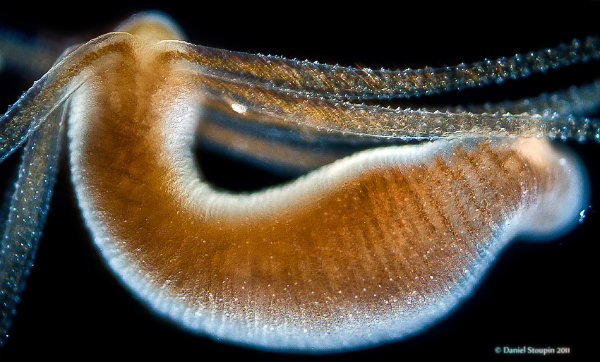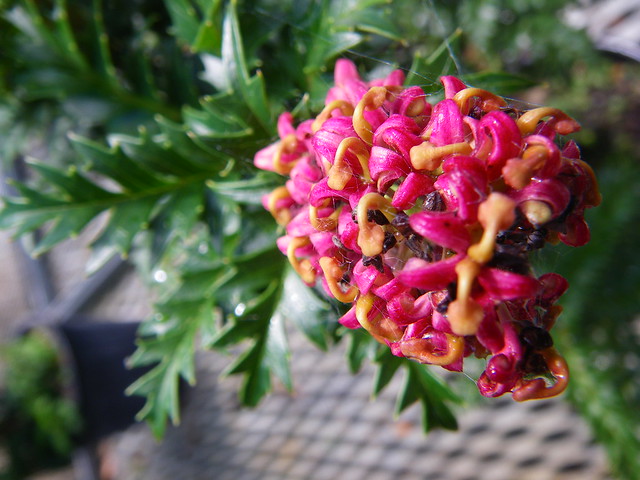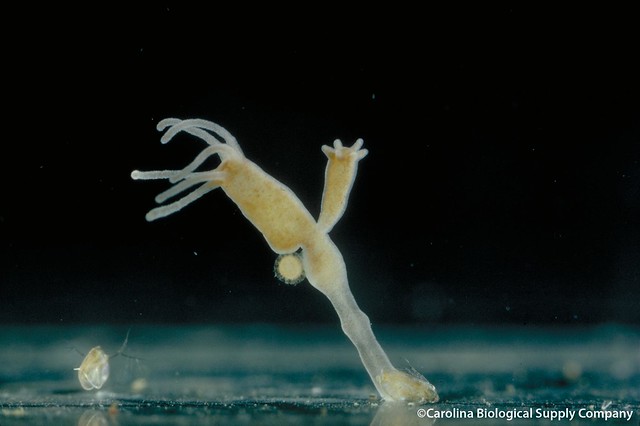| Immortal Hydra |
There is evidence that mortality directly correlates to the shortening of Telomeres on each individual DNA strand, as cells replicate within the body. The Hayflick limit is the number of times a normal cell population will divide until cell division stops. Empirical evidence shows that the Telomeres associated with each cell's DNA will get slightly shorter with each new cell division until they shorten to a critical length. (1)
| Planarian Flatworm |
#1 Lobsters
Studies suggests that lobsters may not weaken, or lose fertility with age, and that older lobsters may even be more fertile than younger lobsters. This longevity may be due to telomerase, an enzyme that repairs long repetitive sections of DNA sequences at the ends of chromsomes, referred to as telomeres. Telomerase is expressed by most vertebrates during embryonic stages, but is generally absent from adult stages of life. However, unlike most vertebrates and invertebrates, lobsters express Telomerase as adults throughout most of their tissue, which is likely related to their longevity.
| Set of genetically identical lobsters. |
#2 Jellyfish
| Turritopsis dohrnii, the immortal jellyfish. |
The immortal jellyfish, is a species of small jellyfish which is found in the Mediterranean Sea and in the waters of Japan. It is the only animal capable of reverting completely to a sexually immature, colonial stage after having reached sexual maturity as a solitary stage. This version of immortality is truly unique in the animal kingdom, in that the organism regresses back to an immature stage in its life cycle, instead of reverting to a replication or a biologically identical version of itself. Theoretically, this process can go on indefinitely but most Turritopsis are likely to succumb to predation or disease, without ever reverting back to their polyp form.
#3 Hydras
 |
| Hydra |
Hydras are a genus of simple, freshwater animals possessing radial symmetry and no post-mitotic cells. The fact that all cells continually divide allows defects and toxins to be diluted. It has been suggested that hydras do not undergo senescence, and as such are biologically immortal. The transcription factor, "forkhead box O" (FoxO) has been identified as a critical driver of the continuous self-renewal of Hydra.
In molecular biology and genetics, the transcription factor (sometimes called a sequence-specific DNA-binding factor) is a protein that binds to specific DNA sequences, thereby controlling the rate of transcription of genetic information from DNA to messenger RNA. This means that it can effectively control the loss of Telomeres in it's DNA, preventing loss of information and therefore rendering itself biologically immortal. Although like the immortal jellyfish, Hydras can succumb to injury or disease.
#4 Sanicula
Sanicula is a genus of plants in family Apiaceae (or Umbelliferae), belonging to the same family in which the carrot and parsnip belong. The common names usually include the label sanicle or black snakeroot. Sanicula is a herb, native to Europe and the Americas, which lives about 70 years in the wild. Old saniculae do not die at a higher rate than younger ones. Theoretically, an individual Sanicula could live forever, provided it did not succumb to injury.
#5 King Clone
| King Clone, the 11,700-year-old creosote bush ring in the Mojave Desert. California. |
#6 King's Lomatia
 |
| Immortal King's Lomatia |
King's Lomatia (Lomatia tasmanica) is a Tasmanian shrub from the family Proteaceae. King's Lomatia is unusual in that all of the remaining plants are genetically identical. Because it has three sets of chromosomes (a triploid) and is therefore sterile, reproduction occurs only vegetatively: when a branch falls, that branch can then grow new roots, establishing a new plant that is genetically identical to its parent.
Although all the plants are technically separate, in that each has its own root system, they are collectively considered to be one of the oldest living plant clones. Each plant's life span is approximately 300 years, but the plant has been cloning itself for at least 43,600 years (possibly up to 135,000 years). This estimate is based on the radiocarbon dating of fossilized leaf fragments that were found 8.5 km (5.3 mi) away.
#7 Planarian Flatworms
| Immortal Planarian Flatworm |
Planarian flatworms (both sexual and asexual) appear to exhibit an ability to live indefinitely and have an "apparently limitless [telomere] regenerative capacity fueled by a population of highly proliferative adult stem cells".
Planaria can be cut into pieces, and each piece can regenerate into a complete organism. Cells at the location of the wound site proliferate to form a blastema that will differentiate into new tissues and regenerate the missing parts of the piece of the severed planaria. It's this feature that gives them the famous designation of being "immortal under the edge of a knife."
| Planarian Flatworm regeneration after being cut into sections with knife. |
What is unique and exciting about the Planarian Flatworm is that even after their heads were removed and regrew, the flatworms could still remember the simple training researchers put them through before the “incident.” This might indicate that Planarian memories reside, not just in the brain, but possibly elsewhere in their bodies.
The scientists are not completely positive but they speculate epigenetics—heritable changes in gene function that do not change the underlying DNA sequence—may have something to do with these curious findings.
7 Biologically Immortal Organisms, The Faces of Immortality, planarian flatworm, immortal jellyfish, hydra, lobster, jellyfish, snakeroot, king clone, clone. cloning, immortality, kings lomatia,7 Biologically Immortal Organisms, The Faces of Immortality, planarian flatworm, immortal jellyfish, hydra, lobster, jellyfish, snakeroot, king clone, clone. cloning, immortality, kings lomatia,7 Biologically Immortal Organisms, The Faces of Immortality, planarian flatworm, immortal jellyfish, hydra, lobster, jellyfish, snakeroot, king clone, clone. cloning, immortality, kings lomatia,7 Biologically Immortal Organisms, The Faces of Immortality, planarian flatworm, immortal jellyfish, hydra, lobster, jellyfish, snakeroot, king clone, clone. cloning, immortality, kings lomatia,7 Biologically Immortal Organisms, The Faces of Immortality, planarian flatworm, immortal jellyfish, hydra, lobster, jellyfish, snakeroot, king clone, clone. cloning, immortality, kings lomatia,7 Biologically Immortal Organisms, The Faces of Immortality, planarian flatworm, immortal jellyfish, hydra, lobster, jellyfish, snakeroot, king clone, clone. cloning, immortality, kings lomatia,7 Biologically Immortal Organisms, The Faces of Immortality, planarian flatworm, immortal jellyfish, hydra, lobster, jellyfish, snakeroot, king clone, clone. cloning, immortality, kings lomatia,7 Biologically Immortal Organisms, The Faces of Immortality, planarian flatworm, immortal jellyfish, hydra, lobster, jellyfish, snakeroot, king clone, clone. cloning, immortality, kings lomatia,7 Biologically Immortal Organisms, The Faces of Immortality, planarian flatworm, immortal jellyfish, hydra, lobster, jellyfish, snakeroot, king clone, clone. cloning, immortality, kings lomatia,7 Biologically Immortal Organisms, The Faces of Immortality, planarian flatworm, immortal jellyfish, hydra, lobster, jellyfish, snakeroot, king clone, clone. cloning, immortality, kings lomatia,7 Biologically Immortal Organisms, The Faces of Immortality, planarian flatworm, immortal jellyfish, hydra, lobster, jellyfish, snakeroot, king clone, clone. cloning, immortality, kings lomatia,7 Biologically Immortal Organisms, The Faces of Immortality, planarian flatworm, immortal jellyfish, hydra, lobster, jellyfish, snakeroot, king clone, clone. cloning, immortality, kings lomatia,7 Biologically Immortal Organisms, The Faces of Immortality, planarian flatworm, immortal jellyfish, hydra, lobster, jellyfish, snakeroot, king clone, clone. cloning, immortality, kings lomatia,7 Biologically Immortal Organisms, The Faces of Immortality, planarian flatworm, immortal jellyfish, hydra, lobster, jellyfish, snakeroot, king clone, clone. cloning, immortality, kings lomatia,7 Biologically Immortal Organisms, The Faces of Immortality, planarian flatworm, immortal jellyfish, hydra, lobster, jellyfish, snakeroot, king clone, clone. cloning, immortality, kings lomatia,
 Share on Tumblr
Share on Tumblr











0 comments:
Post a Comment
Note: only a member of this blog may post a comment.